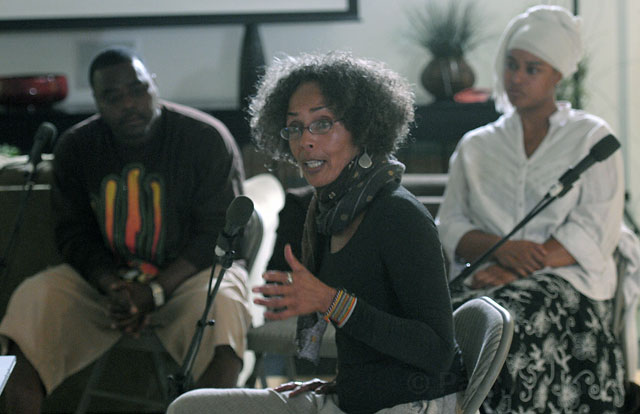A Different Kind of Justice
Young Troublemakers Afforded the Chance to Make Things Right

Early claps of Monday night’s thunderstorm cut Fania Davis off mid-sentence during her talk about peacekeeping among Oakland middle school students.
The second time around, the lights went out.
“I guess I better let someone else do the talking,” Davis joked to the audience of about 20 or so community members, organizers, and school officials.
In a talk dubbed “Surviving the System: Keeping Youth of Color in School and in the Community,” Davis and other members of Restorative Justice of Oakland Youth (RJOY) came to share ideas on how specific deterrence techniques are used in Oakland and how this could be applied in Santa Barbara schools, communities, and juvenile justice system.
Restorative justice is an approach that focuses on the needs of the victims and offenders instead of the need to satisfy punishment assigned by law. Victims of crimes are given a direct role, while offenders are encouraged to take responsibility for their actions (i.e., returning stolen money, apologizing, or doing community service).
“The [current] system is a system that harms people who harm people then tells people it’s not okay to harm people,” Davis said. “This program invites all people who are affected to dialogue.”
Restorative justice can be applied toward the penalties for almost all crimes except homicide. In Oakland, Davis said, restorative diversion has been enforced among juveniles charged with everything from arson to assault and burglary.
Davis talked about the different techniques of restorative justice such as victim-offender dialogue, peacemaking circles, and the importance of a third-party mediator.
Eric Butler, a New Orleans native who found himself in Oakland after Hurricane Katrina, now works with RJOY, where he mentors middle school kids. For Butler, learning how to forgive is the most important facet of justice.
When his sister was murdered by her boyfriend in January, he learned even to forgive the killer’s mother who showed up at the funeral. But that wasn’t his first intent. When he first received the call from the woman who wanted to apologize for her son’s actions, he couldn’t believe she had the nerve.
“So I called my cousins who were gangsters,” Butler said. “I wanted revenge.”
When she arrived, the room filled with mourning family members fell silent. After falling to her knees, she apologized. Then the healing began.
“The forgiveness rang through like a wave, like that thunder tonight,” Butler said. “Restorative justice has a lot to do with forgiveness. If the victim won’t forgive, then it’s just a waste of time.”
Butler now calls the woman Auntie.
Through the help of restorative justice programs in Oakland, RJOY has made its mark.
Since 2007, West Oakland Middle School has eliminated violent fights and expulsions and reduced suspension rates by more than 75 percent.
Putting youth offenders through such programs instead of juvenile hall could also save money, said representatives. For example, institutionalizing one youth costs $5,500 compared to the $2,500 that could otherwise be spent in a restorative justice program.
Santa Barbara School District Superintendant Brian Sarvis said that local schools could go further by implementing a restorative process instead of suspending a child for two days.
“It’s not effective to just send students home for two days,” Sarvis said. “What’s most effective is using that time to deal with their behavior.”
Roane Akchurin, manager of the Community Housing Office at UCSB, has been using restorative justice for nine years in instances such as food fights, damage to halls, and theft cases.
“Any time someone gets in trouble, they have the opportunity to make things better,” Akchurin said.
Tara Haaland-Ford, vice president of Santa Barbara Teen Legal Clinic, works with local juveniles and is a big supporter of restorative diversion.
“Restorative justice for juveniles is the way to go,” Haaland-Ford said. “It puts a whole different face to what someone’s done.”


